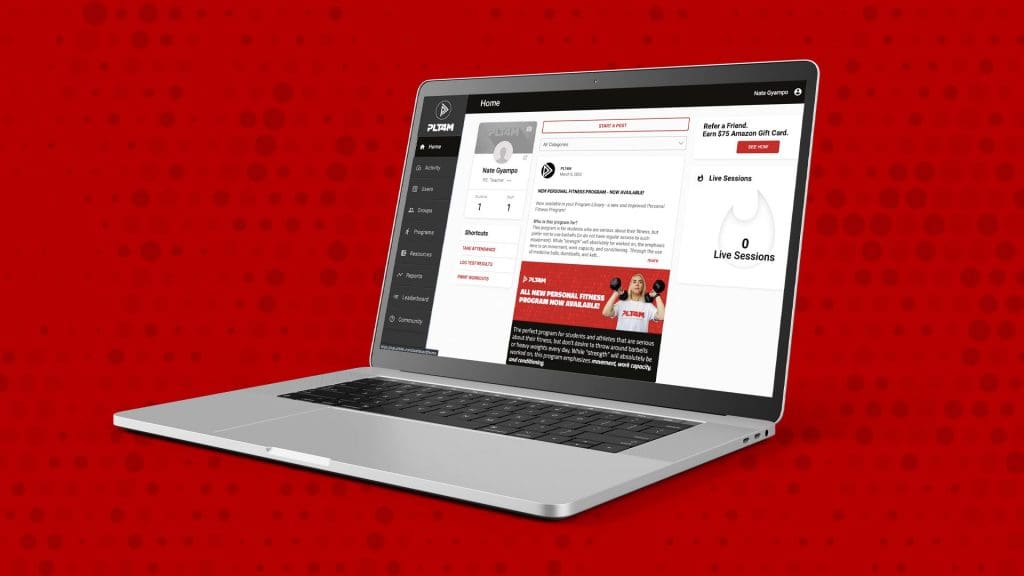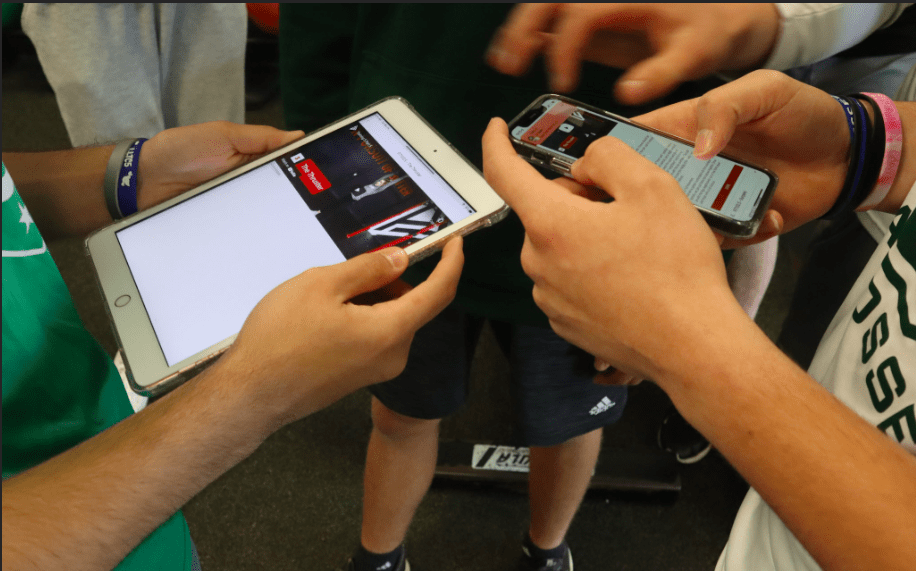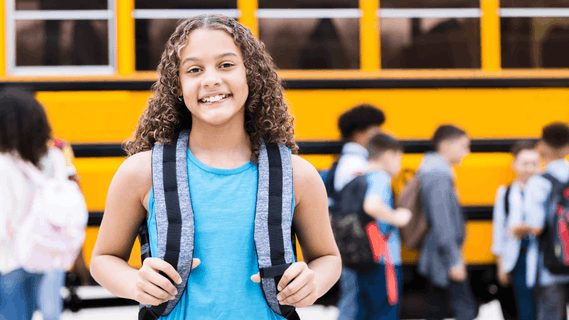Sean Fullerton is a former secondary physical education teacher and current Ph.D. student at the University of New Mexico in the Health, Exercise, and Sports Science Department. In this article, Sean explores flipped learning in physical education and its application with technology. Be on the lookout for lots of great content from Sean as he helps take the academic angle of physical education best practices.

Introduction
Technology has the potential to be an effective instructional tool within physical education (PE) (Krause et al., 2017), and teachers are expected to have the pedagogies to develop “technology-rich” learning environments (Wyant et al., 2015, p. 132). Flipped learning (FL), also known as blended instruction, is an instructional model that inverts the traditional model of content acquisition by using class time to apply content that is taught outside of the classroom using technology (Killian et al., 2019; Loo et al., 2016).
What is Flipped Learning?
The flipped learning model of instruction focuses on the time when students are outside of the classroom to interact with content, carried out through digital technologies created by the teachers (Lucena et al., 2019). A student-centered learning environment is emphasized in FL, where students come to class and pose questions, hold brief discussions, and apply what is learned through accessing the content before class (Ozdamli & Asikosoy, 2016).
Rather than a traditional teacher-centered classroom where the teacher leads and instructs students through a lesson, students are given the opportunity to apply their knowledge in class with the guidance of the teacher. Flipped learning places more responsibility on students for their learning and has been shown to improve participation, motivation, increased self-control, and individual regulation of learning by students (Lucena et al., 2016).
Even though much of the evidence of flipped learning’s effectiveness in PE is anecdotal, it appears that it can enhance learning by delivering content outside of class time.

Free Professional Development For PE
From full courses to on-demand webinars, tap into the PLT4M classroom for continuing education opportunities for physical education teachers.
Different Types of Flipped Learning
There are different types of flipped learning models. Three models found most common are:
- Traditional
- Partial
- Holistic
Traditional
In the traditional flipped model approach, students come to class after watching videos and accessing digital content the night before, and classes start with a short question and answer period (Ozdamli & Asiksoy, 2016). Most of the class time is spent through active learning and applying content knowledge. Students are given the opportunity to learn by discussing.
Partial
The partial flipped approach is a less strict FL model where students are encouraged to access digital content outside of the classroom but are not required to or punished if they do not (Ozdamli & Asiksoy, 2016).
Holistic
The holistic flipped approach treats both at-home and in-class learning environments as learning spaces because they are all “supported and monitored” (Ozdamli & Asiksoy, 2016, p. 102). Unlike traditional flipped learning, students in the holistic FL approach are monitored within and without in-class time. For example, digital content would include documentation of completion within this model.
What is not Flipped Learning?
To promote the efficacy of FL, it is important to understand what flipped learning is not. FL is not simply online videos and digital resources accessed by students to replace the role of the teacher (Ozdamli & Asiksoy, 2016). It is designed to increase interaction between students and teacher.
Flipped learning needs to be utilized in a systematic way where digital content is aligned with in-class activities. “It is not students spending all course period in front of a computer….studying alone” (Ozdamli & Asiksoy, 2016, p. 100).
Flipped Learning In Physical Education
In PE, the flipped learning/blended approach at first glance provides many attractive advantages. The first and most obvious is maximizing in-class physical activity time. Because content can be introduced outside of class, the teacher may not need to spend as much time instructing while in class, increasing time spent being physically active.
Another advantage of FL/blended approach within PE is the ability for students to revisit content outside of class and to pause and rewind videos. Often in PE, students are given a demonstration in class, then asked to synthesize and apply the information immediately.
In the FL/blended approach, the student can rewatch and revisit content before and after class or even access content during class time when the teacher is not available. Flipped learning has been shown to improve motivation through providing the relevancy of activities to health-related fitness, promoting content knowledge acquisition without sacrificing physical activity time during class (Østerlie & Mehus, 2020).
Limitations of Flipped Learning
There are limitations to FL/blended approach that should be considered when implementing. Students may not access content ahead of time, there often will be an acclimation period for students to become accustomed to accessing content through digital means outside of class. Hopefully, when students see the utility of having access to course content at their fingertips and the content is relevant and meaningful, they will be more inclined to review content ahead of time and outside of class. Teachers may also find it difficult to find appropriate online videos, and creating content may be time-consuming.
Flipped Learning with PLT4M – School News Tab
PLT4M includes multiple features that can be used within the FL or blended approach. For example, the “School News” feature in PLT4M is where teachers can post content, links, images, and videos for students. This tab reads like a social media feed where the most recent content is displayed first.
This feature is advantageous because the teacher can assign specific videos and has the autonomy to create content relevant to upcoming classes that students can access beforehand. This School News tab is very versatile in that teachers can link google forms, Youtube videos, website links, or simply write directly in the text window for students. Additionally, the teacher does not have to create instructional videos as PLT4M provides a catalog of high-quality and succinct videos within the app.
PLT4M can provide an easily accessible app-based “one-stop shop” for a PE course, in that, students do not necessarily have to log into inflexible online software interfaces to access course content (i.e. Canvas, Blackboard, etc.). Content delivered through the School News feature can also include cross-curricular teaching such as health-education, nutrition, and relevant health-related fitness content. Students can access content later if they are working on project-based assignments, such as creating an individualized exercise program.

Additional Flipped Learning Opportunities With PLT4M
Additional features in PLT4M can be applied to the flipped learning model such as having access to exercise videos and training programs. During remote learning, students can complete at home workouts that can be documented through the app.
Students also have access to their fitness testing data, so they are able to complete goal-setting assignments ahead of class time, again having the potential to maximize in-class activity time. Teachers can post in-class assignments or study guide resources in the School News tab which can minimize the need to print out resources. This access to content has the potential to improve literacy skills, as reading content-specific vocabulary can enrich the traditionally listening-heavy discipline of PE.
It is important to note that FL or blended instruction should be carefully integrated into a PE course, promoting autonomy and flexibility. The partial FL approach appears to be in line with the features that PLT4M offers, with documentation of learning only occurring through the tracking of workouts, specific to the holistic approach. It may not be possible to track whether students accessed content ahead of time, but if it is interesting, important, and useful, they are more likely to do so.
Because PLT4M is an app-based software, the ease at which a student can access content from their smartphone can alleviate many of the traditional barriers to technology integration such as access to a computer or laptop. A student could access content during the bus ride to school, during lunch, or after school. Students still have the option to access the app through a home or school desktop.
To maximize efficiency, a teacher can plan and organize content at the beginning of the school year and simply copy and paste into the School News tab during the assigned week. It would be suggested to post weekly, rather than daily content. It appears this unique School News feature, along with the others that the PLT4M app offers, has the potential to maximize class time and enhance content knowledge of students through FL/blended instruction.
Free Professional Development For PE
From full courses to on-demand webinars, tap into the PLT4M classroom for continuing education opportunities for physical education teachers.
Key Takeaways On Flipped Learning In Physical Education
To summarize, there are some recommendations when implementing a Flipped Learning approach in physical education.
- A hybrid approach may be most appropriate when using PLT4M, unless instruction is fully remote.
- Make content relevant, meaningful, and essential to in-class activities. Create a “one-stop-shop” of content that is aligned to in-class learning experiences.
- Post weekly so that students have the week to synthesize content. Can include various types of posts throughout the week to include weekly vocabulary, or a “technique tip” for the week.
- Preparation is key, prepare content ahead of time in a word document and simply copy and paste to School News.
- Be patient and consistent, remind students to access content, especially during the initial phase of implementing Flipped Learning.
- Be creative and succinct. Utilize google forms for polls, record a brief Powerpoint presentation with voice over, use images/diagrams when posting that help students conceptualize content, or create a table to display content in an easy to digest format.
- Provide autonomy – gather topics from students that they would like to learn about and tailor content to the needs of the students.
References
Killian, C. M., Kinder, C. J., & Woods, A. M. (2019). Online and Blended Instruction in K–12 Physical Education: A Scoping Review. Kinesiology Review, 8(2), 110–129. https://doi.org/10.1123/kr.2019-0003
Krause, J. M., Franks, H., & Lynch, B. (2017). Current Technology Trends and Issues Among Health and Physical Education Professionals. The Physical Educator, 74(1), 164–180. https://doi.org/10.18666/tpe-2017-v74-i1-6648
Loo, J. L., Eifler, D., Smith, E., Pendse, L., He, J., Sholinbeck, M., Tanasse, G., Nelson, J. K., & Dupuis, E. A. (2016). Flipped Instruction for Information Literacy: Five Instructional Cases of Academic Librarians. The Journal of Academic Librarianship, 42(3), 273–280. https://doi.org/10.1016/j.acalib.2016.03.001
Hinojo Lucena, F. J., López Belmonte, J., Fuentes Cabrera, A., Trujillo Torres, J. M., & Pozo Sánchez, S. (2019). Academic Effects of the Use of Flipped Learning in Physical Education. International Journal of Environmental Research and Public Health, 17(1), 276. https://doi.org/10.3390/ijerph17010276
Other Related Links
Other Articles From Sean Fullerton
How cool is this!?
— PLT4M (@PLT4M) April 29, 2022
Sean Fullerton presenting his research at the national @SHAPE_America conference.
Sean is taking a deep dive into the use of technology and PLT4M in secondary physical education. pic.twitter.com/pjZG0mopzM











